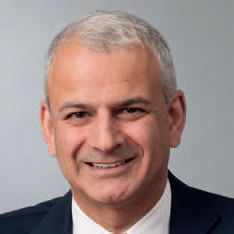A changing environment

Ron Mobed, CEO of Elsevier, shares his thoughts on research trends, open access, and publisher profit-margins
What key trends do you see?
Over the past four to five years funding bodies have often looked at research spend, and how they can reduce it. It causes a lot of pain but has almost always ended up with funding staying the same – or even increasing – because research is important. However, what I hear more and more from academics is the pressure to explain the benefits of what they do to the taxpayer.
Another trend is that research is changing. More and more is digital and quantitative in nature, and research information is moving from static to more dynamic. That’s in many ways driven by technology, helping research scientists navigate vast quantities of data.
A third trend is the changing balance in the proportion of research done in developing countries. Even 10 years ago, the research spend in developing countries was small. This has changed drastically.
Many good industry-wide initiatives have been going on for some time to help give these researchers information access free or very cheaply. In addition, we see some emerging countries – those countries that have seen rapid GDP growth like China and India – starting to put much more funding in research.
While research spend has increased, the level of education on how to write and submit articles and select journals has been lower. At Elsevier we’ve been able to show very quickly to these researchers how to publish good-quality articles. That’s helped with eliminating the separation between good science in developed countries and good science in countries where the infrastructure is not so strong.
We are starting to see more attention to the discipline mix of research, and which areas institutions spend money on. There is enormous competition for the very best researchers, and we start to see specialisation. This allows us to think how to support researchers in different disciplines. The needs of a neuroscience group are very different from those of an astrophysics group in, for example, speed of dissemination, structure of the data, the number of authors on each paper, and how people search. We are thinking about different needs, drilling down discipline by discipline and thinking: ‘If you are a research scientist in this field, this is the information you’ll probably want...’
What are your comments about criticisms by researchers?
I’ve been at Elsevier a few years. Before I joined I was aware of sentiments about the company. Although people named Elsevier, the concerns applied to publishing more generally. I think that Elsevier, and perhaps other publishers, were hesitant to engage with the research community especially through things like social media.
But once we get past the headline discussions, by and large I find scientists very keen to engage with us. We have hundreds of employees who’ve been scientists and Elsevier has been around for 130 years to help scientists. When we engage with researchers on a one to one basis I often get the reaction: ‘I didn’t know you did this’.
What about your profit levels?
We know that people talk about pricing and profit levels. A few years ago there was a big rise across the industry. My guess was that a lot of this extra money was spent on developments in platforms and technology. However, in recent years usage has gone up because users can access content from their desktops or mobile devices, so the unit price has gone down year on year – in common with many electronic products.
We also know some institutions have been putting increasing pressure on their libraries, and some of the budget impacts have come down on information providers. We have tried to help and moderate our pricing when there is real hardship. At the same time there has been investment and expansion in new markets and that is what has driven our profit levels up. We are adding new institutions as customers every single year but that doesn’t reflect badly on the value for existing customers.
What are your thoughts on open access?
One of the things from the Finch report is that research information is an ecosystem. Changes in one part can have unintended consequences elsewhere. Elsevier has many people from different backgrounds working in different functions. We have a perspective that is fairly wide ranging so the idea of an ecosystem has a high resonance with us.
Open access (OA) is part of the ecosystem, and a good part, but we want to ensure that it is done right. Rather than wait until we have a problem, part of our job is to think about the implications. Elsevier has worked in OA for a number of years and has significantly ramped up our efforts. We don’t see any downside to OA as a concept but without direction it is a challenge. Both OA and subscription models can exist and we will come to some kind of equilibrium. We don’t have a driving direction towards either one.
What about acquisitions?
We are here to help researchers be better and more efficient in their day-to-day research. Some things we purchase from others because it’s quicker than doing ourselves and some are complementary to what we do.
Knovel and Mendeley were essentially platform acquisitions. The true value of the Mendeley acquisition will not be realised in 2013/14 but in the future. Sometimes acquisitions are not about technology but about content, for example Woodhead Publishing.
The overall strategy is about plotting the path of where we add value. There are challenges for Elsevier but, when we talk internally, we talk a lot more about opportunities. When you walk the corridors of Elsevier, people are pretty excited.
Interview by Siân Harris






